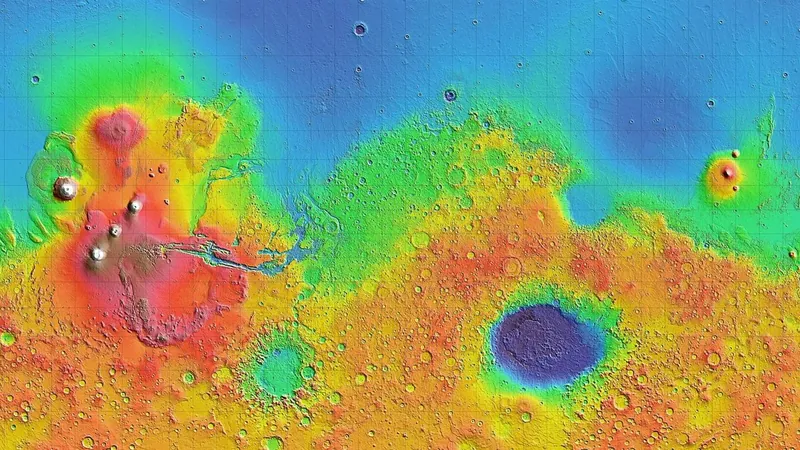
Unlocking Mars' Secrets: How 'Marsquakes' Could Finally Explain the Planet's Mysterious Split!
2025-01-21
Author: Rajesh
Unlocking Mars' Secrets: How 'Marsquakes' Could Finally Explain the Planet's Mysterious Split!
In a groundbreaking revelation, data collected from the NASA InSight lander may have unraveled a 50-year-old enigma surrounding Mars—specifically, why the planet exhibits such stark geographical differences between its northern and southern hemispheres.
Since the 1970s, scientists have noted the contrasting features of Mars: the northern lowlands stretch across two-thirds of the northern hemisphere, while the southern highlands rise, on average, about 3 miles (5 kilometers) higher. The southern region's crust is also significantly thicker, creating a planetary phenomenon termed the 'Martian dichotomy.'
Two leading theories have emerged regarding the origins of this dichotomy. The first suggests that the discrepancy was produced by unknown internal processes within Mars. The second theory proposes that a colossal collision with a moon-sized object, or even multiple smaller impacts, reshaped the landscape. Researchers have long grappled with these theories, especially since the age of the surface rocks indicates that whatever event caused this imbalance occurred in Mars' formative years, complicating efforts to pinpoint a specific cause.
However, a new study published in December 2024 in the journal Geophysical Research Letters presents evidence collected by NASA's InSight lander, which has meticulously recorded the seismic waves generated by detected marsquakes. Located at the interface between the two zones, InSight enabled scientists to analyze how these seismic waves propagated through the mantle beneath both the northern lowlands and the southern highlands.
Interestingly, the study revealed a crucial difference: seismic waves dissipated energy more rapidly in the southern highlands. This discrepancy is primarily attributed to hotter molten rock residing beneath this region, an indication that supports the theory of an internal origin for the Martian dichotomy rather than an external impact.
"Comparing these two areas showed that the waves lost energy more quickly in the southern highlands," the researchers noted. "This temperature difference between the two halves of the divide suggests the split was influenced by internal forces rather than celestial collisions."
The team posits that this temperature variation may be emblematic of ancient tectonic activity that has since waned. "There was a time when Mars had tectonic plates similar to those on Earth. The dynamics of these plates and the underlying molten rock could have formed the dichotomy as we see it today," they stated. As tectonic movement ceased, Mars developed what scientists refer to as a "stagnant lid" over its molten interiors.
In this scenario, magma in the southern region is pushed upward against the crust, while the northern magma sinks toward the core, providing a plausible explanation for the thickness of the crust in the southern highlands.
However, it is crucial to remain cautious about outright dismissing the external impact theory. Recent studies indicate that this perspective still holds potential validity.
The research team emphasized, "To definitively determine what caused the Martian dichotomy, we require more data from marsquakes and more intricate models of Mars' formation." Nonetheless, this study sheds light on a significant piece of the Martian puzzle and leaves the door open for further discoveries.
Stay tuned, as the mysteries of Mars continue to unfold, with each new discovery potentially changing our understanding of our planetary neighbor!




 Brasil (PT)
Brasil (PT)
 Canada (EN)
Canada (EN)
 Chile (ES)
Chile (ES)
 Česko (CS)
Česko (CS)
 대한민국 (KO)
대한민국 (KO)
 España (ES)
España (ES)
 France (FR)
France (FR)
 Hong Kong (EN)
Hong Kong (EN)
 Italia (IT)
Italia (IT)
 日本 (JA)
日本 (JA)
 Magyarország (HU)
Magyarország (HU)
 Norge (NO)
Norge (NO)
 Polska (PL)
Polska (PL)
 Schweiz (DE)
Schweiz (DE)
 Singapore (EN)
Singapore (EN)
 Sverige (SV)
Sverige (SV)
 Suomi (FI)
Suomi (FI)
 Türkiye (TR)
Türkiye (TR)
 الإمارات العربية المتحدة (AR)
الإمارات العربية المتحدة (AR)